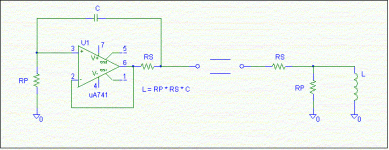Hi there.
I've read a few places that there are 3 ways of making a gyrator circuit, but only very little of technical kind, like detailed circuit description and equations.
Anyone got any links or literature, where I can learn more, and satisfy my theoretical couriousity?
I've read a few places that there are 3 ways of making a gyrator circuit, but only very little of technical kind, like detailed circuit description and equations.
Anyone got any links or literature, where I can learn more, and satisfy my theoretical couriousity?
phase_accurate said:Tietze-Schenk (the EE's "bible") is one place where it is described quite well.
Uh oh... I must have become a heathen somewhere along the
line. What's the title?
Thanks,
eL
When you say gyrator, is that the same as oscillator as in the Hartley, Colpitz and Armstrong oscillators that the FCC used to want me to know all about?
Gyrators?
Hoffmeyer,
If I remember correctly, I had a book, Transform Methods in Circuit Analysis by Harrison, that describes mathematical methods in a discussion on gyrators. He shows a couple of examples of how to use them to simulate inductors in filter circuits. The whole dicussions was based on op-amps. I think the book is out of print and was not very popular so, it may be hard to find it.
Later,
Hoffmeyer,
If I remember correctly, I had a book, Transform Methods in Circuit Analysis by Harrison, that describes mathematical methods in a discussion on gyrators. He shows a couple of examples of how to use them to simulate inductors in filter circuits. The whole dicussions was based on op-amps. I think the book is out of print and was not very popular so, it may be hard to find it.
Later,
One thing I haven't seen but am tempted to play with is the use of chip amps to make power gyrators for speaker crossovers. It might be cool for doing "infinite-slope" sort of implementations or shaping LF response.
Wow, it's been more than 35 years since I sat down in the little test area in our local FCC office for my Advanced ticket. I remember Hartley and Colpitts, but not Armstrong. What is that? (There was also a Pierce, which IIRC was crystal-based)
is that the same as oscillator as in the Hartley, Colpitz and Armstrong oscillators that the FCC used to want me to know all about?
Wow, it's been more than 35 years since I sat down in the little test area in our local FCC office for my Advanced ticket. I remember Hartley and Colpitts, but not Armstrong. What is that? (There was also a Pierce, which IIRC was crystal-based)
Rod discusses Gyrators in this parametric eq project.
http://sound.westhost.com/project28.htm
I've built this circuit and it works. Just be sure to add a 100 ohm seies resistor in the output to prevent oscillation when driving cables.
Phil
http://sound.westhost.com/project28.htm
I've built this circuit and it works. Just be sure to add a 100 ohm seies resistor in the output to prevent oscillation when driving cables.
Phil
memory fails me....
Yikes! I'm not so sure right now, have to go hit the bookcase tommorow to if I got the name right and what it might be.
Whats your monkey smoking?
-Dave
but not Armstrong.
Yikes! I'm not so sure right now, have to go hit the bookcase tommorow to if I got the name right and what it might be.
Whats your monkey smoking?
-Dave
Whats your monkey smoking?
You win the prize for being the first to notice. Yes, it's what you think it is. This is a monkey who will never get around to doing anything other than hoovering Ding-Dongs and getting Phish concert tickets.
Thanks friends.
I knew some of it, but not all, and that's the great thing about this forum. You get reminded of the things you ought to know, besides getting new directions.
Now I'll do some reading, before playing around.
Da5id4Vz:
I'm shure it's being used in oscillators, since it's another way of making an inductor.
I knew some of it, but not all, and that's the great thing about this forum. You get reminded of the things you ought to know, besides getting new directions.
Now I'll do some reading, before playing around.
Da5id4Vz:
I'm shure it's being used in oscillators, since it's another way of making an inductor.
If you just want to simulate an inductor there is a much simpler circuit available, using a single op-amp only.
Regards
Charles
Regards
Charles
I'd like to know everything, so please enlighten me Charles.
I'm in the phase where I'm gathering as much info as possible, even info I know allready. It might come handy to others in this forum.
I'm in the phase where I'm gathering as much info as possible, even info I know allready. It might come handy to others in this forum.
- Status
- Not open for further replies.
- Home
- Amplifiers
- Solid State
- Gyrators ?
